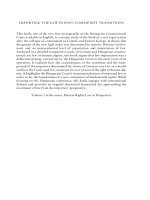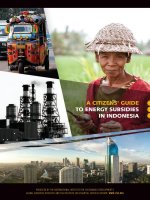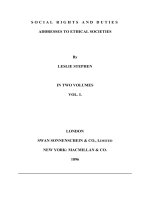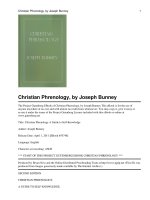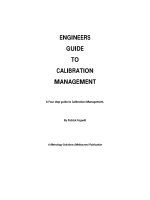Plant Engineers and Managers Guide to Energy Conservation pptx
Bạn đang xem bản rút gọn của tài liệu. Xem và tải ngay bản đầy đủ của tài liệu tại đây (9.68 MB, 439 trang )
iii
Plant Engineers
and Managers
Guide to Energy Conservation
Eighth Edition
Albert Thumann, P.E., C.E.M.
MARCEL DEKKER, INC.
New York and Basel
THE FAIRMONT PRESS, INC.
Lilburn, Georgia
Copyright © 2002 by The Fairmont Press.
Library of Congress Cataloging-in-Publication Data
Thumann, Albert.
Plant engineers and managers guide to energy conservation/
Albert Thumann 8th ed.
p cm
Includes bibliographical references and index.
ISBN 0-88173-384-9 (electronic)
1. Factories Energy conservation Handbooks, manual, etc. I. Title.
TJ163.5.F3 T48 2001
658.2'6 dc21
2001045119
Plant engineers and managers guide to energy conservation by Albert
Thumann
©2002 by The Fairmont Press. All rights reserved. No part of this
publication may be reproduced or transmitted in any form or by any
means, electronic or mechanical, including photocopy, recording, or any
information storage and retrieval system, without permission in writing
from the publisher.
Published by The Fairmont Press, Inc.
700 Indian Trail, Lilburn, GA 30047
tel: 770-925-9388; fax: 770-381-9865
Distributed by Marcel Dekker, Inc.
270 Madison Avenue, New York, NY 10016
tel: 212-696-9000; fax: 212-685-4540
Printed in the United States of America
10 9 8 7 6 5 4 3 2 1
0-88173-384-9 (The Fairmont Press, Inc.)
0-8247-0925-X (Marcel Dekker, Inc.)
While every effort is made to provide dependable information, the publisher, authors, and
editors cannot be held responsible for any errors or omissions.
Copyright © 2002 by The Fairmont Press.
THIS BOOK IS DEDICATED TO THE ENGINEERS,
ARCHITECTS, AND DESIGNERS WHO ARE IMPROVING
ENERGY
EFFICIENCY OF OPERATIONS IN A
COST
-EFFECTIVE MANNER.
Copyright © 2002 by The Fairmont Press.
Contents
Chapter 1 THE ROLE OF THE PLANT ENGINEER
IN ENERGY MANAGEMENT
Survey Of What Industry Is Doing, Results of Industrial Energy
Utilization Programs, Organization For Energy Utilization, What
Is An Industrial Energy Audit?, The Energy Utilization Program,
Energy Accounting, The Language Of The Energy Manager
Chapter 2 ENERGY ECONOMIC DECISION MAKING
Life Cycle Costing, Using The Payback Period Method, Using Life
Cycle Costing, The Time Value Of Money, Investment Decision-
Making, The Job Simulation Experience, Making Decisions For
Alternate Investments, Depreciation, Tax Reform Act, Computer
Analysis
Chapter 3 THE FACILITY SURVEY
Comparing Catalogue Data With Actual Performance, Infrared
Equipment, Measuring Electrical System Performance, Tempera-
ture Measurements, Measuring Combustion Systems, Measuring
Heating, Ventilation And Air-Conditioning (HVAC) System Per-
formance
Chapter 4 ELECTRICAL SYSTEM OPTIMIZATION
Applying Proven Techniques To Reduce The Electrical Bill, Why
The Plant Manager Should Understand The Electric Rate Struc-
ture, Electrical Rate Tariff, Power Basics—The Key To Electrical
Energy Reduction, Relationships Between Power, Voltage, And
Current, What Are The Advantages Of Power Factor Correction?,
Efficient Motors, Synchronous Motors And Power Factor Correc-
tion, What Method Should Be Used To Improve The Plant Power
Factor?, What Is Load Management?, What Have Been Some Of
The Results Of Load Management?, Application Of Automatic
Load Shedding, How Does Load Demand Control Work?, The
Confusion Over Energy Management Systems, Lighting Basics—
The Key To Reducing Lighting Wastes, Lighting Illumination Re-
Copyright © 2002 by The Fairmont Press.
quirements, The Efficient Use of Lamps, Control Equipment, Solid
State Ballasts
Chapter 5 UTILITY AND PROCESS SYSTEM OPTIMIZATION
Basis Of Thermodynamics, The Carnot Cycle, Use Of The Specific
Heat Concept, Practical Applications For Energy Conservation,
Furnace Efficiency, Steam Tracing, Heat Recovery, The Mollier
Diagram, Steam Generation Using Waste Heat Recovery, Pumps
And Piping Systems, Distillation Columns, Incorporation Of En-
ergy Utilization In Procurement Specifications
Chapter 6 HEAT TRANSFER
The Importance Of Understanding The Principles Of Heat Trans-
fer, Three Ways Heat Is Transferred, How To Estimate The Heat
Loss Of A Vessel Or Tank, How To Estimate The Heat Loss Of
Piping And Flat Surfaces
Chapter 7 REDUCING BUILDING ENERGY LOSSES
Energy Losses Due To Heat Loss And Heat Gain, Conductivity
Through Building Materials, The Effect Of Sunlight, Window
Treatments, Building Design Considerations
Chapter 8 HEATING, VENTILATION AND AIR-CONDITIONING
SYSTEM OPTIMIZATION
Efficient Use Of Heating And Cooling Equipment Saves Dollars,
Applying The Heat Pump To Save Energy, Efficient Applications
Of Refrigeration Equipment, Basics Of Air Conditioning System
Design For Energy Conservation, Applying Variable Air Volume
Systems, Applying The Economizer Cycle, Applying Heat Recov-
ery, Cool Storage System Performance, Thermal Storage Control
Systems, The Ventilation Audit, Energy Analysis Utilizing Simu-
lation Programs, Test And Balance Considerations
Chapter 9 COGENERATION: THEORY AND PRACTICE
Definition of "Cogeneration," Components of a Cogeneration Sys-
tem, An Overview of Cogeneration Theory, Application of the Co-
generation Constant, Applicable Systems, Basic Thermodynamic
Cycles, Detailed Feasibility Evaluation
Copyright © 2002 by The Fairmont Press.
Chapter 10 ESTABLISHING A MAINTENANCE PROGRAM FOR
PLANT EFFICIENCY AND ENERGY SAVINGS
Good Maintenance Saves $, What Is The Effectiveness Of Most
Maintenance Programs?, How To Turn Around The Maintenance
Program, Stop Leaks And Save, Properly Operating Steam Traps
Save Energy, Excess Air Considerations, Dirt And Lamp Lumen
Depreciation Can Reduce Lighting Levels By 50%, Summary
Chapter 11 MANAGING AN EFFECTIVE ENERGY
CONSERVATION PROGRAM
Organizing For Energy Conservation, Top Management Commit-
ment, What To Consider When Establishing Energy Conservation
Objectives, Using The Critical Path Schedule Of Energy Conserva-
tion Activities, Electrical Scheduling Of Plant Activities, An Effec-
tive Maintenance Program, Continuous Conservation Monitoring,
Are Outside Consultants And Contractors Encouraged To Save
Energy By Design?, Encouraging The Creative Process, Energy
Emergency And Contingency Planning
Chapter 12 INDUSTRIAL POWER MONITORING AND CONTROL
Evolution of Power Monitoring and Control Systems, First Gen-
eration PC Based Systems, Second Generation Systems, Commer-
cial Technology Today, Systems Architecture, Survey of PM&C
Systems, Vendor Selection
Chapter 13 RELIABLE AND ECONOMIC NATURAL GAS
DISTRIBUTED GENERATION TECHNOLOGIES
Elements of DG, Technologies, Market Potential
Chapter 14 FINANCING ENERGY EFFICIENCY PROJECTS
Financing Alternatives, General Obligation Bond,
Municipal Lease, Commercial Loan, Taxable Lease
Chapter 15 STEAM SYSTEM OPTIMIZATION: A CASE STUDY
Savings Opportunities
Copyright © 2002 by The Fairmont Press.
Chapter 16 COST CONTAINMENT DESIGN FOR
COMMERCIAL GEOTHERMAL HEAT PUMPS
Why GHPs? Why Now?, Design Methods to Realize Advantages,
Software, Challenges in the US Market
Chapter 17 FUNDAMENTALS OF ENERGY OUTSOURCING
What is Outsourcing?, Energy Outsourcing, Planning Steps,
What to Outsource, Barriers to the Success of Outsourcing,
Characteristics of an Energy Management Firm,
Chapter 18 ECONOMIC EVALUATIONS FOR POWER
QUALITY SOLUTIONS
The Principle Investigation, Determining the Phenomenon,
Choosing the Right Equipment, Economic Analysis, Graphical
Analysis, A More Direct Approach
Chapter 19 PURCHASING STRATEGIES FOR ELECTRICITY
AT&T vs. MCI: A Paradigm, Factors Impacting Power Prices,
Three General Relationships, Who Offers These Options?, The
College of Power Knowledge
Chapter 20 POWER QUALITY CASE STUDIES
Case Study 1, Case Study 2
Copyright © 2002 by The Fairmont Press.
Preface
In the year 2000 energy again made the headlines. Energy manage-
ment programs that became dormant were revitalized. Companies again
became aware that the energy problems of the 1970s, 1980s and 1990s did
not go away. The California “power crisis” indeed could spread to other
states and not only impact a company’s profitability but could also put
many out of business.
The first edition of Plant Engineers and Managers Guide was written
in 1977 and it was the first book to address the need for industrial energy
management.
The new edition of this book includes new technologies not avail-
able to the facility manager 25 years ago. Distributed generation,
geoexchange and gas cooling technologies have emerged as new options
available. Deregulation of the utility industry and purchasing power
directly emerged only a few years ago as a new energy strategy.
The role of the energy manager is ever changing. If one lesson can be
learned from the past it is that a comprehensive energy conservation
program is crucial for every company.
Today the stakes are higher than ever and the plant engineer's and
manager’s roles in energy have never been greater.
Albert Thumann
Copyright © 2002 by The Fairmont Press.
Introduction
Plant engineers and managers of the 21st century are expected to
apply new technologies, purchase energy at the best price and keep their
plants running despite power outages. It is clear that energy conservation
is part of every plant engineer's and manager's job.
It is also clear that applying this technology has significant rewards.
In a recent survey conducted by the Association of Energy Engi-
neers, 22.2% of members surveyed have reduced accumulated costs by $5
million or more. The potential for additional savings is still great. Thirty-
six percent of those surveyed indicated further savings amounting to
over 10% were possible.
As we embark on the new century it has become clear that global
competitiveness and energy conservation go hand in hand. Energy con-
servation means good business. Energy conservation means eliminating
waste and insuring operations are more productive. Energy conservation
means improving the quality of industrial facility management and pre-
venting pollution. Energy conservation means improving the environ-
ment through pollution prevention, and minimizing global warming
trends.
The role of the energy manager is ever changing. Today’s energy
manager must understand how to negotiate the best electric and gas
contract as well as understand how to incorporate new energy-efficient
technologies into plant operations. The energy manager must have a keen
understanding of all aspects of plant operations from purchasing prac-
tices to organizational structure. The energy manager must seek out new
financing opportunities to fund energy-efficient projects.
The challenge has always been great. The stakes, however, are
higher than ever.
Copyright © 2002 by The Fairmont Press.
The Role of the Plant Engineer in Energy Management 1
1
The Role of the Plant Engineer
In Energy Management
Energy management is now considered part of every plant
engineer’s job. Today the plant engineer needs to keep abreast of chang-
ing energy factors which must be incorporated into the overall energy
management program. The accomplishments of energy management
have indeed been outstanding. In a 1998 opinion survey conducted by
the Association of Energy Engineers, 22.2 percent of those responding
indicated that they have saved their companies at least five million
dollars in accumulated energy costs since being employed. Eighteen
percent had slashed energy costs 26 percent or more since the program
was started.
Safety, maintenance and now energy management are some of the
areas in which a plant engineer is expected to be knowledgeable. The
cook book and low cost-no cost energy conservation measures which
were emphasized in the 1970s have been replaced with a more sophis-
ticated approach.
The plant engineer of the 2000s must have a keen understanding of
both the technical and managerial aspects of energy management in
order to insure its success. When oil prices dropped in 1986 it was an
opportunity in many plants to switch back to oil. As electric prices es-
calated it was an opportunity for many plants to install cogeneration
facilities. In the late 1990s deregulation took hold, opening up new op-
portunities in energy purchasing. Thus the energy management area is
ever changing.
Energy management or energy utilization has replaced the simplis-
tic house keeping measures approach.
The intent of this book is not to make you an expert in each subject,
Copyright © 2002 by The Fairmont Press.
2 Plant Engineers and Managers Guide to Energy Conservation
but to illustrate how the overall pieces fit together. Each chapter illus-
trates the various pieces that comprise an industrial energy utilization
program. The energy manager is analogous to a system engineer. Only
when the total picture is viewed will the solution become obvious. Of
course, it should be noted that the energy manager must seek the advice
of experts or specialists when required and use their expertise accord-
ingly.
ORGANIZATION FOR ENERGY UTILIZATION
A multi-divisional corporation usually organizes energy activities
on a corporate and plant basis. On the plant basis, energy activities are
in many instances added on to the duties of the plant manager.
An energy utilization program does not just happen. It needs a
guiding force to “get the ball rolling.” Production, energy costs, and raw
material supplies are of great concern to plant managers; thus, they are
usually the ones to initiate the program.
For a continual, ongoing program to develop, energy managers
need to establish “the industrial audit program” for their facilities. The
term “industrial audit” was introduced in most energy utilization pro-
grams in the late 1970s, yet it was rarely defined.
WHAT IS AN INDUSTRIAL ENERGY AUDIT?
The simplest definition for an energy audit is as follows: An en-
ergy audit serves the purpose of identifying where a building or plant
facility uses energy and identifies energy conservation opportunities.
There is a direct relationship to the cost of the audit (amount of
data collected and analyzed) and the number of energy conservation op-
portunities to be found. Thus, a first decision is made on the cost of the
audit, which determines the type of audit to be performed.
The second decision is made on the type of facility. For example,
a building audit may emphasize the building envelope, lighting, heat-
ing, and ventilation requirements. On the other hand, an audit of an
industrial plant emphasizes the process requirements.
Most energy audits fall into three categories or types: namely, walk-
through, mini-audit, or maxi-audit.
Copyright © 2002 by The Fairmont Press.
The Role of the Plant Engineer in Energy Management 3
Walk-through. This type of audit is the least costly and identifies
preliminary energy savings. A visual inspection of the facility is made to
determine maintenance and operation energy saving opportunities plus
collection of information to determine the need for a more detailed
analysis.
Mini-audit. This type of audit requires tests and measurements to
quantify energy uses and losses and determine the economics for
changes.
Maxi-audit. This type of audit goes one step further than the mini-
audit. It contains an evaluation of how much energy is used for each
function, such as lighting or process. It also requires a model analysis,
such as a computer simulation, to determine energy use patterns and
predictions on a year-round basis, taking into account such variables as
weather data.
The chief distinction between the mini-audit and the walk-through
audit is that the mini-audit requires a quantification of energy uses and
losses and determining the economics for change.
The chief distinction between the maxi-audit and the mini-audit is
that the maxi-audit requires an accounting system for energy to be es-
tablished and a computer simulation.
THE ENERGY UTILIZATION PROGRAM
The energy utilization program usually contains the following
steps:
1. Determine energy uses and losses; refer to checklist, Table 1-1.
2. Implement actions for energy conservation, refer to checklist,
Table 1-2.
3. Continue to monitor energy conservation efforts; refer to
checklist, Table 1-3.
Determine Energy Uses and Losses
Probably the most important aspect of an ongoing energy utiliza-
tion program is to make individuals “accountable” for energy use.
Unfortunately, many energy managers find it difficult to economi-
cally justify “root metering.” The savings as a result of increased ac-
countability are difficult to measure.
Copyright © 2002 by The Fairmont Press.
4 Plant Engineers and Managers Guide to Energy Conservation
Table 1-1. Checklist to determine energy uses and losses.
————————————————————————————————
SURVEY ENERGY USES AND LOSSES
A. Conduct first survey aimed at identifying energy wastes that can be cor-
rected by maintenance or operations actions, for example:
1. Leaks of steam and other utilities
2. Furnace burners out of adjustment
3. Repair or addition of insulation required
4. Equipment running when not needed
B. Survey to determine where additional instruments for measurement of en-
ergy flow are needed and whether there is economic justification for the
cost of their installation
C. Develop an energy balance on each process to define in detail:
1. Energy input as raw materials and utilities
2. Energy consumed in waste disposal
3. Energy credit for by-products
4. Net energy charged to the main product
5. Energy dissipated or wasted
Note: Energy equivalents will need to be developed for all raw materials, fuels,
and utilities, such as electric power, steam, etc., in order that all energy
can be expressed on the common basis of Btus.
D. Analyze all process energy balances in depth:
1. Can waste heat be recovered to generate steam or to heat water or a
raw material?
2. Can a process step be eliminated or modified in some way to reduce
energy use?
3. Can an alternate raw material with lower energy content be used?
4. Is there a way to improve yield?
5. Is there justification for:
a. Replacing old equipment with new equipment requiring less en-
ergy?
b. Replacing an obsolete, inefficient process plant with a whole new
and different process using less energy?
E. Conduct weekend and night surveys periodically
F. Plan surveys on specific systems and equipment, such as:
1. Steam system
2. Compressed air system
3. Electric motors
4. Natural gas lines
5. Heating and air conditioning system
————————————————————————————————
Source: NBS Handbook 115.
Copyright © 2002 by The Fairmont Press.
The Role of the Plant Engineer in Energy Management 5
Table 1-2. Checklist for energy conservation implementation.
————————————————————————————————
IMPLEMENT ENERGY CONSERVATION ACTIONS
A. Correct energy wastes identified in the first survey by taking the necessary
maintenance or operation actions
B. List all energy conservation projects evolving from energy balance analy-
ses, surveys, etc.
Evaluate and select projects for implementation:
1. Calculate annual energy savings for each project
2. Project future energy costs and calculate annual dollar savings
3. Estimate project capital or expense cost
4. Evaluate investment merit of projects using measures, such as return
on investment, etc.
5. Assign priorities to projects based on investment merit
6. Select conservation projects for implementation and request capital
authorization
7. Implement authorized projects
C. Review design of all capital projects, such as new plants, expansions,
buildings, etc., to assure that efficient utilization of energy is incorporated
in the design.
Note: Include consideration of energy availability in new equipment and plant
decisions.
————————————————————————————————
Source: NBS Handbook 115.
(Continued)
Table 1-3. Checklist to develop
continuous energy conservation efforts.
————————————————————————————————
DEVELOP CONTINUING ENERGY CONSERVATION EFFORTS
A. Measure results:
1. Chart energy use per unit of production by department
2. Chart energy use per unit of production for the whole plant
3. Monitor and analyze charts of Btu per unit of product, taking into consid-
eration effects of complicating variables, such as outdoor ambient air tem-
perature, level of production rate, product mix, etc.
a. Compare Btu/product unit with past performance and theoretical
Btu/product unit
b. Observe the impact of energy saving actions and project implementa-
tion on decreasing the Btu/unit of product
Copyright © 2002 by The Fairmont Press.
6 Plant Engineers and Managers Guide to Energy Conservation
c. Investigate, identify, and correct the cause for increases that may occur
in Btu unit of product, if feasible
B. Continue energy conservation committee activities
1. Hold periodic meetings
2. Each committee member is the communication link between the com-
mittee and the department supervisors represented
3. Periodically update energy saving project lists
4. Plan and participate in energy saving surveys
5. Communicate energy conservation techniques
6. Plan and conduct a continuing program of activities and communica-
tion to keep up interest in energy conservation
7. Develop cooperation with community organizations in promoting en-
ergy conservation
C. Involve employees
1. Service on energy conservation committee
2. Energy conservation training course
3. Handbook on energy conservation
4. Suggestion awards plan
5. Recognition for energy saving achievements
6. Technical talks on lighting, insulation, steam traps, and other subjects
7. “savEnergy” posters, decals, stickers
8. Publicity in plant news, bulletins
9. Publicity in public news media
10. Letters on conservation to homes
11. Talks to local organizations
D. Evaluate program
1. Review progress in energy saving
2. Evaluate original goals
3. Consider program modifications
4. Revise goals, as necessary
————————————————————————————————
Source: NBS Handbook 115.
Table 1-3. (Continued)
————————————————————————————————
Copyright © 2002 by The Fairmont Press.
The Role of the Plant Engineer in Energy Management 7
Table 1-1 (B) indicates, as part of the initial survey, that a determi-
nation should be made as to who is responsible for which area or pro-
cess and where “root metering” would have the biggest impact.
Implement Actions for Energy Conservation
Once energy usage is known potential energy conservation
projects can be identified. Each project will be recommended on the
basis of the annual energy savings projected and the initial investment
required.
Continue to Monitor Energy Conservation Efforts
Energy usage needs to be tracked by using a common energy con-
sumption base per unit of production. This tracking will allow quick
identification of changes in energy consumption.
The remaining portion of this chapter will illustrate the language
of energy conservation and its applications.
ENERGY ACCOUNTING
An important part of the overall energy auditing program is to be
able to measure where you are, and determine where you are going. It
is vital to establish an energy accounting system at the beginning of the
program. Figures 1-1 through 1-3 illustrate how energy is used for a
typical industrial plant. It is important to account for total consumption,
cost, and how energy is used for each commodity such as steam, water,
air, and natural gas. This procedure is required to develop the appropri-
ate energy conservation strategy.
The top portion of Figure 1-1 illustrates how much energy is used
by fuel type and its relative percentage. The pie chart below shows how
much is spent for each fuel type. Using a pie chart representation or
nodal flow diagram can be very helpful in visualizing how energy is
being used.
Figure 1-2, on the other hand, shows how much of the energy is
used for each function such as lighting, process, and building heating
and ventilation. Pie charts similar to the right-hand side of the figure
should be made for each category such as air, steam, electricity, water,
and natural gas.
Figure 1-3 illustrates an alternate representation for the steam dis-
tribution profile.
Copyright © 2002 by The Fairmont Press.
8 Plant Engineers and Managers Guide to Energy Conservation
Figure 1-2. Energy profile by function.
Figure 1-1. Energy use and cost profile.
ENERGY USE PROFILE
ENERGY COST PROFILE
30% ELECTRICITY
3 X 10
9
BTU/YR
12% DIESEL OIL
1.2 X 10
9
BTU/YR
8% GASOLINE
.8 X 10
9
BTU/YR
50% NATURAL GAS
5 X 10
9
BTU/YR
29% NATURAL GAS
$29,000/YR
8.5% GASOLINE
$8,500/YR
12.5% DIESEL OIL
$12,500/YR
50% ELECTRICITY
$50,000/YR
ENERGY DISTRIBUTION PROFILE
HVAC
Buildings
20%
Diesel
Fuel 12%
Gasoline 8%
Process
Ventilation
10%
Lighting
Building
23%
Process
Equipment
27%
Process
40%
Building
Heat
30%
Boiler
Feedwater
Heat
20%
Steam Leaks
6%
Domestic
Hot Water 4%
STEAM DISTRIBUTION PROFILE
Copyright © 2002 by The Fairmont Press.
The Role of the Plant Engineer in Energy Management 9
One of the more important as-
pects of energy management and con-
servation is measuring and accounting
for energy consumption. At Carbor-
undum an energy accounting and
analysis system has been developed
which is unique in industry, a simple
but powerful analytical, management
decision-making tool. The Office of En-
ergy Programs of the U.S. Department
of Commerce asked Carborundum to
work with them in developing this sys-
tem into a national system, hopefully to
be used in the voluntary industrial con-
servation program. A number of major
U.S. corporations are either using or
are considering using the system pro-
posed. The system is offered to those who want to use it.
Most energy accounting systems have been devised and are admin-
istered by engineers for engineers. The engineers’ principal interest in
developing these systems has been the display of energy consumed per
unit of production. That ratio has been called “energy efficiency,’’ and
changes in energy efficiency are clearly energy conserved or wasted. The
engineer focuses all of his attention on reducing energy consumed per
unit of production.
An energy efficiency ratio alone, however, cannot answer the kinds
of questions asked by business managers and/or government authori-
ties:
• If we are conserving energy, why is our total energy consumption
increasing?
• If we are wasting energy, why is our total energy consumption
decreasing?
• If we have made no change in energy efficiency, why is our energy
consumption changing?
Thus there is a need to evaluate several impacts, such as weather,
volume/mix, and pollution control, which affect energy use.
Figure 1-3. Steam distribution
nodal diagram.
Steam L
eaks 6
%
Process 40%
Building Heat 30%
Boiler Feedwater 2
0%
Hot Water 4%
Steam 100%
Copyright © 2002 by The Fairmont Press.
10 Plant Engineers and Managers Guide to Energy Conservation
Weather Impact
The effect of weather changes (colder winter or hotter summer) on
energy consumption is defined as the change in degree-days in the
periods under discussion times the heating or cooling efficiency in the
period used as the basis for analysis. In the Carborundum system, this
translates into the difference in degree-days this year-to-date and last
year-to-date times the energy used per degree-day last year-to-date. The
monetary impact of weather is the impact calculated as above times the
cost per unit of energy last year-to-date. That is, the impact of weather
changes on energy use or cost is the difference between this period’s
weather and last, times the heating/cooling energy efficiency in the last
or base period. The result ignores improvements in efficiency (identified
later as energy conservation effects) and inflation (identified later as
price effects), and isolates the effect of weather.
Volume/Mix Impact
The impact of volume and/or product mix changes is the amount
of more (or less) energy that is used currently, as opposed to previously,
solely as the result of producing more (or less) product or proportion-
ately more (or less) energy-intense products.
Pollution Control Impact
The impact of the energy increase or decrease to control pollution
in the current period versus any other time period is simply the differ-
ence in the energy used in the two periods. The financial impact is the
impact calculated above multiplied by the cost per unit of energy in the
last period. The result ignores conservation and price effects as before,
and isolates the effect of pollution control.
“Other” Impacts
The impact of other energy uses, previously defined as experimen-
tal, start-up of product lines without history, of base loads, etc., is sim-
ply the difference in energy used in the two periods being compared.
The economic impact is the impact calculated above multiplied by the
cost per unit of energy in the prior period. Again, the result ignores con-
servation and price effects and isolates the effect of these “other” uses of
energy.
Figure 1-4 illustrates the data input form used in the Carborundum
system.
Copyright © 2002 by The Fairmont Press.
The Role of the Plant Engineer in Energy Management 11
Figure 1-4. Carborundum energy accounting
and analysis system data input form.
Carborundum Energy Accounting and
Analysis System Data Input Form
Plant _________________________________________________________
Division ________________________________________________________
Group _________________________________________________________
Today's Date ___________________________________________________
Period Covered ___________________________________________________
————————————————————————————————
Description Elec. kWh Gas mcf Oil gal. Coal lbs. Propane Gal. Other
(000)* (000)* (000)* (000)* (000)*
————————————————————————————————
Total Fuel Used
————————————————————————————————
Quantity
————————————————————————————————
Cost ($)
————————————————————————————————
**Conversion Factor
————————————————————————————————
Production
Product 1
NAME
————————————————————————————————
Production Unit
————————————————————————————————
Quant. Prod. (000)
————————————————————————————————
Fuel Used
————————————————————————————————
Product 2
NAME
————————————————————————————————
Production Unit
————————————————————————————————
Quant. Prod. (000)
————————————————————————————————
Fuel Used
————————————————————————————————
Product 3
NAME
————————————————————————————————
Production Unit
————————————————————————————————
Quant. Prod. (000)
————————————————————————————————
Fuel Used
————————————————————————————————
Product 4
NAME
————————————————————————————————
Production Unit
————————————————————————————————
Quant. Prod. (000)
————————————————————————————————
Fuel Used
————————————————————————————————
Product 5
NAME
————————————————————————————————
Production Unit
————————————————————————————————
Quant. Prod. (000)
————————————————————————————————
Fuel Used
————————————————————————————————
Heating
————————————————————————————————
Degree Days
————————————————————————————————
Fuel Used
————————————————————————————————
Cooling
————————————————————————————————
Degree Days
————————————————————————————————
Fuel Used
————————————————————————————————
Pollution Control
————————————————————————————————
Fuel Used
————————————————————————————————
Other
————————————————————————————————
Fuel Used
————————————————————————————————
**Alternate Fuel
————————————————————————————————
*All Fuel reported in thousands to two decimal places
Energy
Management and
Conservation
Program
Plant Input Data
Copyright © 2002 by The Fairmont Press.
12 Plant Engineers and Managers Guide to Energy Conservation
THE LANGUAGE OF THE ENERGY MANAGER
In order to communicate energy conservation goals and to analyze
the literature in the field, it is important to understand the language of
the energy manager and how it is applied.
Each fuel has a heating value, expressed in terms of the British
thermal unit, Btu. The Btu is the heat required to raise the temperature
of one pound of water 1°F. Table 1-4 illustrates the heating values of
various fuels. To compare efficiencies of various fuels, it is best to con-
vert fuel usage in terms of Btu’s. Table 1-5 illustrates conversions used
in energy conservation calculations.
When comparing the cost of fuels, the term “cents per therm”
(100,000 Btu) is commonly used.
Knowing the energy content of the plant’s process is an important
step in understanding how to reduce its cost. Using energy more effi-
ciently reduces the product’s cost, thus increasing profits. In order to
account for the process energy content, all energy that enters and leaves
a plant during a given period must be measured.
The energy content of various raw materials can be estimated by
using the heating values indicated in Table 1-6.
Table 1-4. Heating values for various fuels.
————————————————————————————————
Fuel Average Heating Value
————————————————————————————————
Fuel Oil
Kerosene 134,000 Btu/gal.
No. 2 Burner Fuel Oil 140,000 Btu/gal.
No. 4 Heavy Fuel Oil 144,000 Btu/gal.
No. 5 Heavy Fuel Oil 150,000 Btu/gal.
No. 6 Heavy Fuel Oil 2.7% sulfur 152,000 Btu/gal.
No. 6 Heavy Fuel Oil 0.3% sulfur 143,800 Btu/gal.
Coal
Anthracite 13,900 Btu/lb.
Bituminous 14,000 Btu/lb.
Sub-bituminous 12,600 Btu/lb.
Lignite 11,000 Btu/lb.
Gas
Natural 1,000 Btu/cu. ft.
Liquefied butane 103,300 Btu/gal.
Liquefied propane 91,600 Btu/gal.
————————————————————————————————
Source: Brick & Clay Record, October 1972.
Copyright © 2002 by The Fairmont Press.
The Role of the Plant Engineer in Energy Management 13
Table 1-5. List of conversion factors.
————————————————————————————————
1 U.S. barrel = 42 U.S. gallons
1 atmosphere = 14.7 pounds per square inch absolute (psia)
1 atmosphere = 760 mm (29.92 in) mercury with density of 13.6
grams per cubic centimeter
1 pound per square inch = 2.04 inches head of mercury
= 2.31 feet head of water
1 inch head of water = 5.20 pounds per square foot
1 foot head of water = 0.433 pound per square inch
1 British thermal unit (Btu) = heat required to raise the temperature of 1 pound
of water by 1°F
1 therm = 100,000 Btu
1 kilowatt (kW) = 1.341 horsepower (hp)
1 kilowatt-hour (kWh) = 1.34 horsepower-hour
1 horsepower (hp) = 0.746 kilowatt (kW)
1 horsepower-hour = 0.746 kilowatt hour (kWh)
1 horsepower-hour = 2545 Btu
1 kilowatt-hour (kWh) = 3412 Btu
To generate 1 kilowatt-hour (kWh) requires 10,000 Btu of fuel burned by average
utility
1 ton of refrigeration = 12,000 Btu per hr
1 ton of refrigeration requires about 1 kW (or 1.341 hp) in commercial air condi-
tioning
1 standard cubic foot is at standard conditions of 60°F and 14.7 psia.
1 degree day = 65°F minus mean temperature of the day, °F
1 year = 8760 hours
1 year = 365 days
1 MBtu = 1 million Btu
1 kW = 1000 watts
1 trillion barrels = 1 × 10
12
barrels
1 KSCF = 1000 standard cubic feet
————————————————————————————————
Note: In these conversions, inches and feet of water are measured at 62°F (16.7°C),
and inches and millimeters of mercury at 32°F (0°C).
Copyright © 2002 by The Fairmont Press.
14 Plant Engineers and Managers Guide to Energy Conservation
Table 1-6. Heat of combustion for raw materials.
————————————————————————————————
Gross Heat of
Formula Combustion Btu/lb
————————————————————————————————
Raw Material
Carbon C 14,093
Hydrogen H
2
61,095
Carbon monoxide CO 4,347
Paraffin Series
Methane CH
4
23,875
Ethane C
2
H
4
22,323
Propane C
3
H
8
21,669
n-Butane C
4
H
10
21,321
Isobutane C
4
H
10
21,271
n-Pentane C
5
H
12
21,095
Isopentane C
5
H
12
21,047
Neopentane C
5
H
12
20,978
n-Hexane C
6
H
14
20,966
Olefin Series
Ethylene C
2
H
4
21,636
Propylene C
3
H
6
21,048
n-Butene C
4
H
8
20,854
Isobutene C
4
H
8
20,737
n-Pentene C
5
H
10
20,720
Aromatic Series
Benzene C
6
H
6
18,184
Toluene C
7
H
8
18,501
Xylene C
8
H
10
18,651
Miscellaneous Gases
Acetylene C
2
H
2
21,502
Naphthalene C
10
H
8
17,303
Methyl alcohol CH
3
OH 10,258
Ethyl alcohol C
2
H
5
OH 13,161
Ammonia NH
3
9,667
————————————————————————————————
Source: NBS Handbook 115.
Copyright © 2002 by The Fairmont Press.
The Role of the Plant Engineer in Energy Management 15
CODES, STANDARDS & LEGISLATION
This section presents a historical perspective on key codes, stan-
dards and regulations which have impacted energy policy and are still
playing a major role in shaping energy usage. The Energy Policy Act of
1992 is far-reaching and its implementation is impacting electric power
deregulation, building codes and new energy-efficient products. Some-
times policy makers do not see the far-reaching impact of their
legislation. The Energy Policy Act, for example, has created an environ-
ment for retail competition. Electric utilities will drastically change the
way they operate in order to provide power and lowest cost. This in
turn will drastically reduce utility-sponsored incentive and rebate pro-
grams which have influenced energy conservation adoption.
THE ENERGY POLICY ACT OF 1992
This comprehensive legislation is far-reaching and impacts energy
conservation, power generation and alternative-fuel vehicles as well as
energy production. The federal as well as private sectors are impacted
by this comprehensive energy act. Highlights are described below:
Energy Efficiency Provisions
Buildings
• Requires states to establish minimum commercial building energy
codes and to consider minimum residential codes based on current
voluntary codes.
Utilities
• Requires states to consider new regulatory standards that would
require utilities to undertake integrated resource planning, allow
efficiency programs to be at least as profitable as new supply op-
tions and encourage improvements in supply system efficiency.
Equipment Standards
• Establishes efficiency standards for commercial heating and air-
conditioning equipment, electric motors, and lamps.
• Gives private sector an opportunity to establish voluntary effi-
Copyright © 2002 by The Fairmont Press.
16 Plant Engineers and Managers Guide to Energy Conservation
ciency information/labeling programs for windows, office equip-
ment and luminaires, or the Department of Energy will establish
such programs.
Renewable Energy
• Establishes a program for providing federal support on a competi-
tive basis for renewable energy technologies. Expands program to
promote export of these renewable energy technologies to emerg-
ing markets in developing countries.
Alternative Fuels
• Gives Department of Energy authority to require a private and
municipal alternative fuel fleet program starting in 1998. Provides
a federal alternative fuel fleet program with phased-in acquisition
schedule; also provides state fleet program for large fleets in large
cities.
Electric Vehicles
• Establishes comprehensive program for the research and develop-
ment, infrastructure promotion and vehicle demonstration for
electric motor vehicles.
Electricity
• Removes obstacles to wholesale power competition in the Public
Utilities Holding Company Act by allowing both utilities and non-
utilities to form exempt wholesale generators without triggering
the PUHCA restrictions.
Global Climate Change
• Directs the Energy Information Administration to establish a base-
line inventory of greenhouse gas emissions and establishes a
program for the voluntary reporting of those emissions. Directs the
Department of Energy to prepare a report analyzing the strategies
for mitigating global climate change and to develop a least-cost en-
ergy strategy for reducing the generation of greenhouse gases.
Research and Development
• Directs the Department of Energy to undertake research and devel-
opment on a wide range of energy technologies, including energy
Copyright © 2002 by The Fairmont Press.
